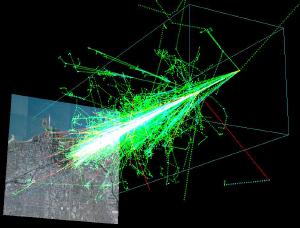Blog
OMG
29 June 2014
 Dinoj Surendran, Mark SubbaRao, and Randy Landsberg
Dinoj Surendran, Mark SubbaRao, and Randy LandsbergWhen the Large Hadron Collider was frantically searching for the Higgs boson, you could hear murmuring speculation about the possibility of the LHC creating black holes that could destroy the Earth. There was a lawsuit filed against Cern in an effort to prevent such a catastrophe. Part of this was fueled by our love of a good doomsday scenario, but part of it was driven by the idea that the LHC was producing the highest energy collisions ever known. While the LHC is humanity’s highest energy particle collider, it doesn’t produce the highest energy collisions known. Much higher collisions are produced by cosmic rays.
Cosmic rays are high energy particles, typically protons, seen to impact the Earth’s atmosphere. The energy of the LHC can accelerate a proton to an energy of about 7 TeV, or 7 trillion electron volts. An electron volt is the amount of energy a proton would get moving across an electric potential of one volt. Seven trillion is a lot of energy for a proton, and means it it traveling at about 99.9999991% of the speed of light. That’s just 3 m/s shy of the ultimate speed limit. Cosmic rays at TeV energies strike the Earth all the time. In a given square kilometer, one will strike every few seconds. These cosmic rays aren’t nearly as efficient at producing exotic particles as the LHC, but they do produce a particle cascade as they strike our atmosphere.
The most powerful cosmic ray was observed in 1991. It was a proton with an energy of 400 million TeV. That’s such an astounding amount of energy that it has been nicknamed the Oh-My-God! particle. At that energy, the proton was moving so close to the speed of light that if it trailed a photon for a year it would only be about 50 nanometers behind. Because of time dilation, its experience of time was extraordinarily slowed relative to us. In traveling a million light years, it would only experience a couple minutes of time.
We still aren’t sure what produces these ultra-high energy cosmic rays. The leading candidates are active galactic nuclei and supernova remnants. The Oh-My-God particle had so much energy that it was likely undeflected by things like galactic magnetic fields, so it was hoped that it could provide a clue as to its source. However in the direction of the OMG particle there isn’t anything that could produce such a high energy particle.
In 2015 the LHC plans to double particle energies to 14 TeV. That is still far less than cosmic particle accelerators, so there’s no need to worry about creating black holes or destroying the Earth through particle research.